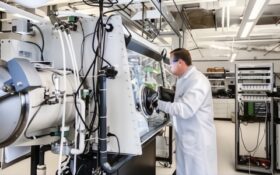The world’s first commercially viable lithium-sulfur battery is on the brink of deployment after a deal between UK firm OXIS Energy and aerospace company Airbus Defence and Space.
OXIS Energy aims to increase its system’s energy density to 425Wh/kg, which would allow a High Altitude Long Pseudo Satellite (HAPS) to fly in the troposphere for three months without needing to land.
The 27-month project is being run through The Zephyr Innovation Programme (ZIP), led by Airbus Defence & Space in Farnborough UK, which is developing the solar-powered HAPS.
The outcome of the project ‘may lead to discussions’ with OXIS to build cells for up to 500 aircraft, but ‘is a matter for future discussions’, a company spokesman told BBB.
If the outcome is successful, it could prove a game changer not only for Oxis, but the technology.
Huw Hampson-Jones, CEO at Oxis, told BBB: “This could potentially be the first large scale deployment of the lithium-sulfur technology in a commercial product and we would expect to see other products come to the market soon afterwards.
“The most likely adjacent markets to use this particular type of lithium-sulfur cell would be expected to be aerospace .
OXIS will be looking to improve both the chemistry and components to hit the 425Wh/kg target. Last year BBB reported how the company had reached its 400Wh/kg milestone after three years or research.
A formal Joint Development Agreements between Oxis and chemical and materials companies such as Arkema, Covestro and Solvay, along with material manufacturers specialising in components used in the composition of the lithium-sulfur cell technology resulted in a series of patents.
This same process will continue to be used to achieve 425Wh/kg and beyond, said Hampson-Jones.
Hampson-Jones said: “OXIS has worked with Airbus for over 30 months. It is not lost on us that it’s because of the strides that OXIS Energy has made in developing its unique technology based on a lithium-sulfur battery chemistry, that we have been selected for this programme.”
A key criterion for Airbus winning this contract is its capability to manufacture 500 aircraft per annum.
Cranfield University, UK, will work on the battery control estimation algorithm, with Ricardo developing the battery management system hardware.
OXIS is one of two companies that have been pushing the boundaries of the emerging technology.
Last year US firm Sion Power announced it too had reached the coveted 400Wh/kg milestone— opening up the possibilities of longer range electric vehicles.
Sion used its patented Licerion®-Ion system technology in its 20 Ahr cell design batteries to hit 700 Wh/L and 350 cycles under 1C discharge conditions.












